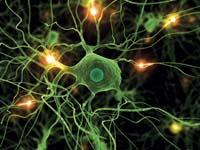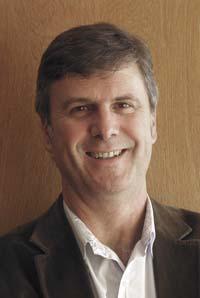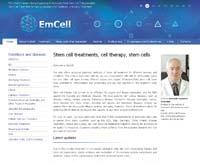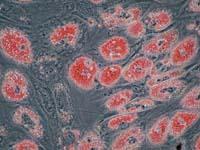Stem cell treatments, new fraud

In April 2006, neurologist Gurutz Linazasoro, in Barcelona, gave a talk about the importance of stem cells in the treatment of parkinson. Among others, he mentioned that embryonic stem cells had a high risk of developing tumors. In fact, embryonic stem cells are very powerful and can be obtained from them any type of cells in the brain, but in turn they are difficult to control, so the risk of developing tumors was very high (since then researchers have managed to reduce the risk in part).
At the end of the talk a man approached him. He was about fifty years old, had Parkinson, and was worried. Very. In fact, he confessed to Linazasoro that he had just come from Kiev. There he went to receive a treatment of embryonic stem cells and listening to the conference feared that the cells that had inserted him damaged him.
Linazasoro asked the man how the stem cells had inserted him. Two intravenous injections and others under the skin. After hearing it, Linazasoro tried to reassure the man and explained that the cells introduced in the vessels cannot cross the blood-brain barrier. That is, it was impossible for these cells (whether stem cells or not) to reach the brain, so Linazasoro ruled out the risk of producing a tumor.
In addition, he proposed to man to follow up. In fact, Gurutz Linazasoro is director of the Polyclinic Gipuzkoa Parkinson Research Center and president of the Inbiomed Foundation, specializing in stem cell research and regenerative medicine.
Thus, the man agreed to perform some tests on how the dopaminergic neurons were. As Linazasoro explains, these tests are called "DatSCAN", and through them you can see how the pathway of dopamine producing neurons is, the path that is affected by Parkinson's disease." Therefore, if the treatment were effective, there would be more dopaminergic neurons than before and would improve the dopaminergic pathway.
Unfortunately, as Linazasoro expected, "the cerebral dopaminergic pathway of this person has not improved." On the contrary, thanks to the follow-up carried out, it has shown that, with the passage of time, Parkinson has been worsening.

For this reason, Linazasoro sent a letter to the scientific journal Science. But the editor misunderstood it and thought that the sick man was sent to Kiev by Linazasoro. "He told me everything," says Linazasoro, "but I immediately clarified that the man went on his own to receive treatment, driven by an advertisement seen on the Internet."
Moreover, half a year later the sick man returned to Kiev. "And he received treatment again for 18,000 euros." Meanwhile, Linazasoro contacted the Kiev doctor, Dr. Alexander Smikodub, to send him a sample of the cells he injected. I wanted to try it in rats, because they have a very good rat model in the laboratory to investigate Parkinson. But Smikodub rejected the request.
He did not answer clearly the questions Linazasoro asked him: what type of cells were exactly, what research he did, where he published the results of his research... The scant explanations given by Smikodub showed that treatment with stem cells was a fraud.
Denunciation scientific community
Several articles published in the most important scientific journals in recent years show that the Barcelona man is not the only one who has suffered fraud and that there are more frauds like Smikodub.

In the article, the writer Martin Enserink mentions some clinics that offer treatments based on stem cells and their peculiarities: some incorporate stem cells from the umbilical cord, other embryonic cells or stem cells obtained from cells taken from the patient. And with them they cure incurable diseases such as multiple sclerosis, Parkinson, Huntington's disease...
The scientific community considers the activities of these clinics suspicious, since they have not demonstrated, at least by the accepted ways, that treatments are effective and safe. And among the suspicious clinics he cites EmCell, whose president is Alexander Smikodub.
Smikodub has also aroused the attention of other media, such as documentary and some BBC articles. In one of them ("Stem cell is my only chance", My only choice is stem cells) appears the following quote from Smikodub: "I often feel the executor of God's desire."
In addition to EmCell and Smikodub, their articles denounce many other clinics and doctors. They are spread all over the world (United States, China, Thailand, Germany...) and have created the expression to designate the patients who travel abroad for treatment: stem cell tourist, tourist stem cell.

Necessary standards and guarantees
With the aim of avoiding fraud, the International Association for Stem Cell Research (ISSCR) published a guide last year. The main objective of this association is the exchange of information on the research of stem cells, and that of the guide, collect scientific, clinical, regulatory, ethical and social aspects that researchers must take into account in order to treat patients with stem cells.
In short, the guide specifies how stem cell research should be carried from the laboratory to the clinic: how to process and characterize cells; what results are obtained in preclinical tests to start testing in people; how to demonstrate efficacy; how to test for toxicity; what information should be provided to patients before receiving stem cell therapy; how to measure the effects of treatments and how to follow up; what data is available in scientific committees...

In fact, the guide offers recommendations and the ISSCR proposes to be the basis for developing standards and laws. The fact that the rules are not harmonized internationally generates serious problems.
However, there are those who believe that too strict a regulation can be counterproductive, with the conviction that the investigations would be stopped. To avoid this risk, two Swedish and American researchers propose alternative processes to develop stem cell based therapies in an article published in Science in June last year
In any case, everyone agrees to avoid fraudulent treatments. And measures are taken. For example, in July last year, four people were detained in a hospital in Budapest for offering unauthorized stem cell treatments. Before that, the Biomark clinic was convicted in the United States for fraud, and in Ireland, Holland and Belize they have also closed treatment centers with stem cells because they did not meet the standards.
No treatments, but side effects are real
However, it is not always easy to stop scammers and, in the meantime, they do much harm. Linazasoro explains that many times it is not known whether patients have suffered side effects or not, but that severe cases appear punctual. This reminds a child of Israel: "He developed a tumor, a teratoma, in the brain, to which stem cells were applied directly to the brain." Currently, the same is being done in some clinics, installing stem cells within the vertebral channel.

In addition, there is the peculiarity that the placebo effect is associated with the increase of dopamine. And that's what's missing in Parkinson, dopamine. "That's why, often, after treatment, the placebo effect causes the symptoms of Parkinson's, such as hand tremor," explains Linazasoro. However, this relief is ephemeral.
All this generates reticences to all the investigations that are carried out with stem cells. In the opinion of Linazasoro, the work of physicians and patient associations is important. Finally, highlights the importance of the media: "Between researchers and patients there is a chain in which all links must act responsibly."
Guide to the International Association for Stem Cell Research (ISSCR): www.isscr.org/clinical_trans/pdfs/ISSCRGLClinical Trans.pdf .





